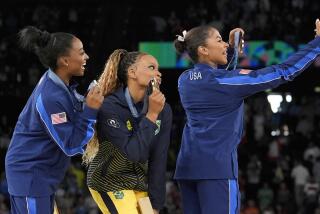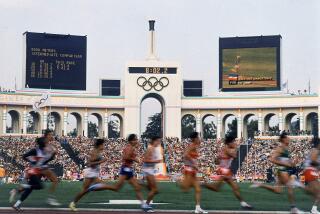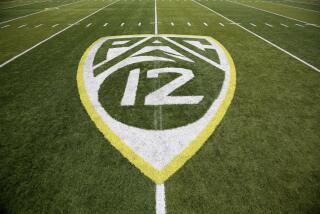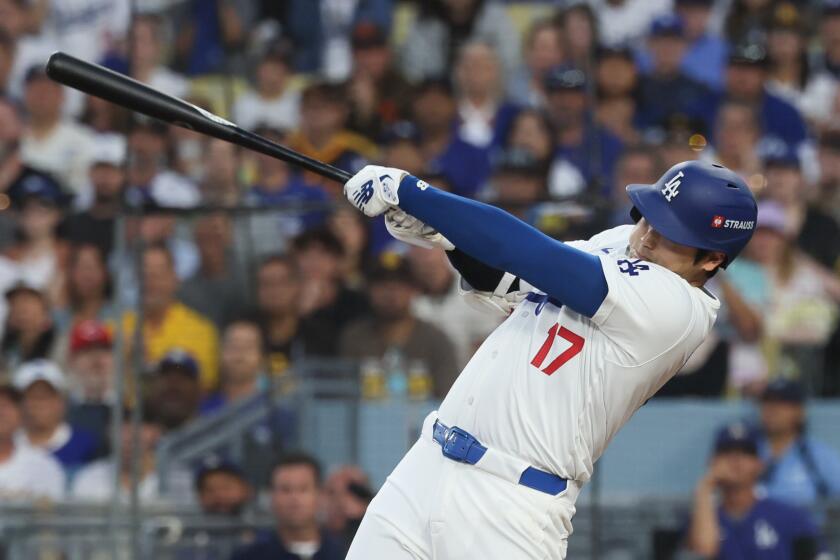China Aims to Become a Major Sports Power by the Year 2000
- Share via
A dozen years ago, the fastest way to forfeit one’s place on a Chinese sports team was to play like a champion.
Officials more interested in diplomacy than sports told athletes to lose in order to brighten an opponent’s visit and enhance foreign relations.
Today, any mention of those old sports constraints will provoke a laugh, a trip to the team psychiatrist or the Chinese equivalent of “Nice guys finish last.”
Athletes from the vast moonscape of Western China to the teeming megatropolis of Shanghai with 12 million people are on a relentless drive to sports supremacy, with friendship taking a backseat.
Drawn from a talent pool of the most populous nation in the world, more than 1 billion people with 40% under 21, China has replaced Japan as the sports emperor of Asia since 1982 and now hopes to quickly broaden its challenge to the United States, Soviet Union and Europe.
The long-range goal is to be a sports superpower by the year 2000, by which time half the population will be engaged in regular physical exercise, says Li Menghua, head of the cabinet-level Commission on Sports and Physical Culture and chairman of China’s Olympic Committee.
If achieved, it will be in time for the 2000 Summer Olympics and the beginning of what economists predict as the Age of the Pacific.
Urged by their international colleagues, Chinese sports officials already are mulling a possible bid for the Summer Games to showcase the country’s emergence as a world-class competitor in all sports. The biggest question mark is whether the government can build adequate facilities. Although new sports facilities are being built for the 1990 Asian Games in Beijing, those will not be enough.
The Chinese Olympic Committee thus is accorded elite status within the head office of the State Council or cabinet, making it a curious fixture next to other sub-departments on science and technological development and the 1997 takeover of Hong Kong.
To realize its dream, China will need major improvements in coaching, training, facilities and nutrition. The recruitment of potential stars also needs refinement, and to do that, the nation’s sports brain trust will divide the country in half.
“In the northern provinces, the people are taller and bigger so we will develop our athletes for basketball, football, volleyball, track and field and swimming,” said Lu Yuanzhen, an official of the Chinese Olympic Committee, devising preparations for the next 15 years of Olympic competition.
“The south produces gymnasts and divers and others whose sport requires a lot of flexibility because that part has smaller, leaner people,” Lu said.
At the 1984 Los Angeles Olympics, China won 15 gold medals in shooting, gymnastics, women’s volleyball, fencing and weightlifting. It also won eight silver and nine bronze medals.
Lu predicts the next advance in Olympics will be in rowing and, of course, table tennis, which China has dominated for decades. But he and other sports authorities are unsure of matching the 1984 medal haul at the 1988 Seoul Olympics, since the Soviet Union and East Germany are competing.
The first step in integrating the nation’s sports program was taken in July 1987 when coaches gathered in Beijing to write a national training manual on all track and field events. Eventually, a manual will be produced for every Olympic sport.
“There is so much work needed it is difficult to think of them all,” said Zhang Zhungyuan, head of China’s 1984 Olympic delegation. “We are still catching up (with the world).”
War, revolution and international politics kept China on the sports sidelines for the first half of this century.
After the 1949 Communist revolution, sports were rejuvenated. Chinese archery competitors set world records in the early 1960s and a handful of track and field athletes even ranked among the world’s top 10.
Then sports died.
The 1966-76 Cultural Revolution paralyzed the nation. Young people rampaged in the streets, not the playgrounds. Teams were disbanded, athletes were sent to communes and factories and international exchanges stopped. Sports lost 10 years of development in the turmoil--and it still has not recovered fully.
By the early 1970s, as the most violent period of the Cultural Revolution ebbed, teams were allowed to form again as goodwill ambassadors of Communist Party Chairman Mao Tse-tung.
In the most significant table tennis matches in global politics, U.S. players were invited to Beijing to play in 1971. “Ping-Pong Diplomacy” was born and Sino-American relations quickly thawed.
When Mao died in 1976, so did most of his ideas, including his dictum of “Friendship First, Competition Second.”
Suddenly, it was possible--and one’s righteous duty--to demolish foreign opponents with a smile. Victories were quickly seen as a way to lift sagging national spirits and win respect abroad. The new rallying cry amounts to: “Friendship, Yes. But We Want Medals, Too.”
As China flung open its doors to the West in 1979 to stoke its economy, sports surged on a tidal wave of exchanges.
When National Basketball Association players visited in 1982 for clinics and exhibition games they stood sheepishly as the crowd laughed during pregame introductions. Chinese spectators thought anyone introduced as a Bull, Rocket or SuperSonic must be joking.
The postgame meal for the victorious Americans produced a gaffe when one player mistakenly identified eels as fishing worms.
Two years ago Hong Kong golf coach Peter Tang crossed into southern Guangdong Province to mold a Chinese national team on a course designed by Arnold Palmer. He was stopped at the border by suspicious customs agents who never saw or heard of golf. Eventually, they allowed Tang to bring one ball for nearly a quarter of mankind.
Now there are several golf courses in China. The first professional golf tournament in the country was held this spring, the Asian leg of the Dunhill Team Cup, in southern Guangdong Province near Hong Kong.
The International Olympic Committee facilitated China’s march on sports by extending membership to the Asian giant at the expense of Taiwan, which was forced to change its name from “China” to “Chinese Taipei.”
Once unshackled, China’s athletes went on a binge. They have won more than 160 world titles, broken about 100 world records and won more than 1,000 gold medals in various competitions since 1980.
While it excels at about one-third of the major sports, especially diving, gymnastics, shooting, volleyball, badminton, weightlifting and table tennis, China is far behind in the glamour events of track and field, swimming and soccer.
The national record for the decathlon, for example, is 7,645 points, more than 1,000 points short of the world record. Similarly, American Jackie Joyner-Kersee’s world-record 7,161 points in the women’s heptathlon is 1,125 points ahead of Dong Yuping, China’s Asian record holder.
Chinese athletes, for the moment, remain at a disadvantage when it comes to coaching, facilities and equipment.
There are now 14 schools for coaches with an enrollment of 10,000. But the studies at these schools are geared toward physical education, not specialized sports training.
Foreign coaches have been invited to train national teams and some competitors, including international diving champion Li Kongzheng, are training in the United States and elsewhere while continuing their studies.
About 5,000 Chinese athletes go abroad each year, but most to compete and only a handful to train. In recent years, China sent a soccer team to Brazil and its judo team to Britain for training. In the past year, an East German coach visited to coach Chinese swimmers. But Chinese officials acknowledge that costs prohibit further international exchange.
More than 1,500 new sports facilities have opened since 1979 but that still falls short of demand. There is a noticeable lack of good soccer fields and only 60 indoor swimming pools exist--one-tenth the number in Japan--and many times they are padlocked because of water shortages, especially in the arid north.
The national sports budget is $270 million, less than 1% of the government’s total outlay.
“We are still not rich in China,” Wu Yui said. “It’s impossible for the government to spend more on sports.”
Everyone connected with sports readily admits the expenditure is inadequate and the key to China’s athletic agenda is its ambitious economic goal of quadrupling the economy by 2000.
“Everything we plan assumes that the economy will improve in the 10 to 20 years,” Zhang Zhungyuan said.
Added Zhang Pinquan, sports editor of the state-run Xinhua News Agency: “When people have more money, their children will eat better and be stronger. The government will have more money to invest and our athletes will have more chances at getting international experience.”
The backbone of China’s athletic development is a national policy that promotes fitness as well as organized sports. Roughly one-third of China’s population participates in some form of athletic activity.
Thanks, in part, to sports publications--the only ones with increasing circulation--and a steady diet of televised sports, the public now partakes of bowling, tennis, billiards, body building and frisbees.
However, that may not produce star athletes. In an article published in March on attitudes toward sports, an official newspaper noted a survey taken in Shanghai in which 65% of the parents polled said their children loved sports. But only 1.2% said they would send their children to sports schools, the first stop toward becoming a full athlete. Other surveys yielded similar results.
“It’ll be no surprise if China falls down in sports,” Zhang Caizheng, vice minister of the National Sports Commission, said in the article.
Lisheng Sporting Goods shop in Beijing, the largest of its kind in China, had a turnover of $8.5 million last year and manager Liu Bin still complains about the lack of supplies.
Coaches at all levels constantly watch for budding stars, who are encouraged to enroll in one of the 33,000 spare-time sports schools. Officials say between 200,000 and 300,000 young athletes currently are training in China.
Most of China’s athletes are from urban areas, which have far more sports facilities than the rural areas.
But rural communities, prospering under new agricultural policies, are investing more into athletic programs. And next year, following the Seoul Olympics, the children of farm families will strut out for the first “China National Peasants Games.”
The best athletes wind up at one of China’s physical education institutes or the sports department of universities. They receive a free education, like their fellow students, and have an enriched diet paid for by the government.
Players on national teams are paid a government stipend and a bonus if they win an event or tournament. A top competitor may receive an annual pay of $2,700 to $5,400 and a coveted, modern apartment after retirement.
The salaried athletes do not draw extra pay for the Olympics but receive food, housing and clothing. However, there is money to be made by performing well at the Games. Breaking a world record can mean $270 to $800. Coaches receive benefits but many earn the average worker’s salary--$30 a month.
In a nation in which the government admits public cynicism toward role models created by the Communist Party, the best athletes unintentionally have filled a political void.
Medalists are elevated to a status comparable to that of a Hollywood movie star, a reflection of China’s shift toward recognizing individual achievement. The marriage of Lang Ping, the nicknamed “Iron Hammer” spiker of the Olympic-winning women’s volleyball team, triggered national press coverage that continued until she moved to California last spring.
Shifts in political winds, however, sway even the stars. Party leaders every so often bemoan negative Western influences, stirring editorials about athletes who neglect ideology for sports and dreams of travel, glory and wealth.
Even the athletes training for the Olympics cannot escape political instruction. According to Wu, they are given several hours of political thought training each week.
It is then up to Li Menghua, the sports czar and member of the powerful Communist Party Central Committee, to get athletes and his bureaucratic Sports Commission to fall in line.
The ideological spasms do not last long enough to cripple teams. The Chinese are soon back to practicing their high-five hand slaps and plotting their next gold medal.
When they do grab the gold, national expectations rise, creating greater pressure.
As Chinese students marched through the streets in December 1986 demanding democratic reforms, a different crisis gripped others--the humiliating defeats a few months earlier of the world-champion Chinese table tennis teams to South Korea.
Radio Beijing launched a phone-in program to examine the losses and for three months, long after the student demonstrations stopped, the issue riveted national attention. One startling conclusion: China does not have enough quality table tennis players.
The groundswell of other sports had diluted enrollment in table tennis training. China’s sports boom had victimized its former No. 1 sport.
A few months later, the Chinese reasserted their supremacy, winning all but one of the events at the world table tennis championships. But sports officials warned that the Europeans are now technically superior.
“I never thought it would happen like this,” a Chinese sports writer said. “They seem to be doing to us in table tennis what we are trying to do to them in all their sports.”
That the Chinese are intensely proud of their athletes is unquestioned. Last October, China beat Japan in Tokyo in a World Cup qualifying soccer game. Within minutes after the game, thousands of young Chinese on bicycles swept through central Beijing, cheering: “Long live the Chinese team.” It was the first spontaneous street demonstration since the previous winter’s student protests.
Editor’s note: Ted Chan followed the development of sports in China while serving in UPI’s Beijing bureau. He currently is an editor on UPI’s Foreign Desk in Washington.
More to Read
Go beyond the scoreboard
Get the latest on L.A.'s teams in the daily Sports Report newsletter.
You may occasionally receive promotional content from the Los Angeles Times.







